SECTION 3-G 1953 BUICK STROMBERG 2-BARREL CARBURETOR AND AUTOMATIC CHOKE
NOTE: For Series 40 procedures see Section 3-G in the 1952 Buick Shop Manual
3-24 DESCRIPTION AND OPERATION OF 1953 BUICK STROMBERG 2-BARREL CARBURETOR
General Description
The 1953 Buick AAVB Stromberg carburetor used on Series 50 engines is a 2-barrel down draft type. See figure 3-56.
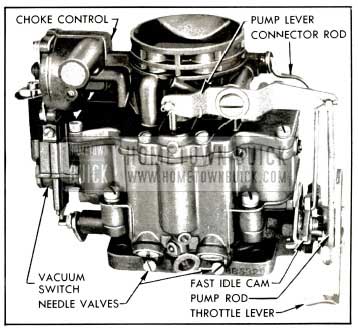
1953 Buick Stromberg AAVB Carburetor Assembly
It contains a float system, idle (low speed) system, main metering (high speed) system, power system, accelerating system, and automatic choke. An accelerator vacuum switch, which is part of the cranking motor control circuit, is incorporated in the 1953 Buick Stromberg 2-barrelcarburetor assembly.
Air is supplied to both barrels of carburetor through the air horn which has one inlet and contains the choke valve. Fuel is supplied to both barrels from one float chamber. The float chamber encircles both barrels and contains a dual type float and lever assembly which actuates one float needle valve. The accelerating pump discharge nozzle in each barrel is supplied with fuel from one pump located in the float chamber. The power system for both barrels is controlled by one vacuum power piston.
Except as noted above, each barrel forms a complete carburetor system. Each barrel contains an idle system with adjustable needle valve, a main metering system, accelerating pump discharge nozzle, primary and auxiliary venturi tubes, and a throttle valve. The throttle valves of both barrels are mounted in line on one stem. The dual construction provides the advantages of two carburetors in one compact unit. The dual carburetor and dual intake manifold provides more uniform distribution of fuel to all cylinders than would be possible with one single barrel carburetor.
Operation of each system of the AAV Stromberg carburetor is described in the following subparagraphs. The automatic choke is described in paragraph 3-25, which follows. The accelerator vacuum switch is described in paragraph 10-30.
Operation of 1953 Buick Stromberg Float System
Fuel enters the 1953 Buick Stromberg 2-barrel carburetor at the gasoline connection and flows through the strainer and needle valve seat into the float chamber. When the fuel reaches the prescribed level in float chamber, the dual float presses the needle valve against its seat to shut off the flow of fuel. Thereafter, the fuel is maintained at the prescribed level by opening and closing of the needle valve as required. The float lever is hinged on a fulcrum pin and connected to the needle valve by a clip. See figure 3-57.
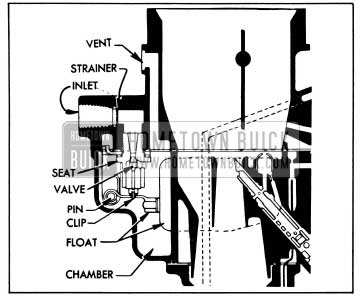
1953 Buick Float System-Stromberg AAVB Carburetor
The float chamber is vented externally through a port in air horn to allow fuel to be smoothly withdrawn through the various systems.
Operation of 1953 Buick Stromberg Idle (Low Speed) System
Fuel is delivered to the engine through the idle system at closed throttle and light load speeds up to approximately 20 MPH. The idle system also partially controls fuel supply for light load speeds up to approximately 30 MPH.
The operation of the idle system in each barrel of the 1953 Buick Stromberg 2-barrel carburetor is identical. Fuel flows from the float chamber through main metering jet and upward through the idle tube which meters the fuel. From the idle tube it flows through a connecting channel where air from the idle air bleeder is mixed with it so that a mixture of air and fuel passes down the idle channel to the idle discharge holes. Additional air is drawn into the fuel air mixture in the idle channel through the secondary air bleeder. See figure 3 58.
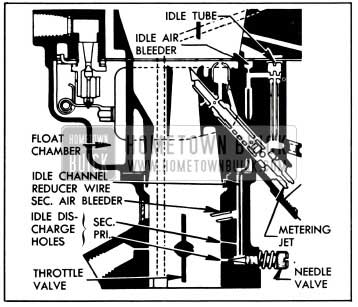
1953 Buick Idle System-Stromberg AAVB Carburetor
On idle or closed throttle operation, the fuel air mixture is drawn only from the lower or primary idle discharge hole due to high suction at this point. As throttle valve is opened, suction is also placed on the upper or secondary idle discharge hole to feed additional fuel. Fuel supplied through the idle discharge holes begins to diminish when the throttle valve is opened to the point where the main metering system begins to supply fuel, as described below, until a throttle position is reached where the idle system ceases to function.
The idle needle valve controls the quantity of fuel that is supplied through the primary idle discharge hole, thereby affecting the final fuel-air ratio supplied to the engine while the idle system is in operation.
Operation of 1953 Buick Stromberg Main Metering System
The main metering system controls the flow of fuel during the intermediate or part-throttle operation, starting at approximately 20 MPH and continuing up to approximately 75 MPH.
The operation of the main metering system in each barrel of the 1953 Buick Stromberg 2-barrel carburetor is identical. Air entering the barrel through the air horn passes through the primary and auxiliary venturi tubes which increase the velocity of the air and create a suction on the main discharge jet. This causes fuel to flow from the float chamber through the main metering jet into the main discharge jet. Air is drawn in through the high speed bleeder so that a mixture of fuel and air is discharged from the main discharge jet into the air stream passing through the auxiliary venturi in the barrel of the carburetor. See figure 3-59.
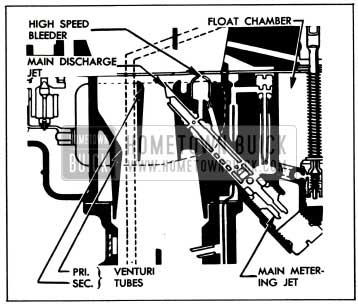
1953 Buick Main Metering System-Stromberg AAVB Carburetor
The main discharge jet is designed so that if any vapor bubbles are formed in the hot gasoline, the vapors will follow the outside channel around the main discharge jet instead of passing through the jet tube. These vapor bubbles escape through the dome-shaped high speed bleeder and thereby reduce percolating troubles.
Operation of Stromberg Power System
For maximum power or high speed operation above approximately 75 MPH a richer mixture is required than that necessary for normal throttle opening. The richer mixture is supplied through the main metering systems of both barrels of carburetor by means of the power system.
The power piston cylinder is connected by a channel to the intake manifold. At part throttle position the manifold vacuum is sufficient to hold the power piston in its “up” position against the tension of the piston spring. When the throttle valve is opened to a point where additional fuel is required for satisfactory operation, the manifold vacuum decreases sufficiently so that the piston spring moves the power piston down to open the power by-pass jet. Opening of the by-pass jet allows additional metered fuel to enter the main discharge jets through a by-pass channel without passing through the restricted main metering jet. See figure 3-60.
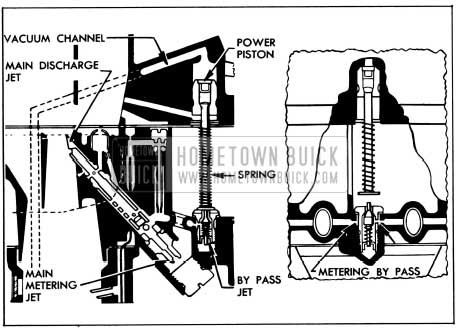
1953 Buick Power System-Stromberg AAVB Carburetor
Operation of 1953 Buick Stromberg Accelerating System
For smooth and rapid acceleration it is necessary to supply an extra quantity of fuel momentarily when the throttle is suddenly opened. This is accomplished by operation of the accelerating pump piston which is directly connected to the throttle valve lever by means of a rod and pump lever. See figure 3-61.
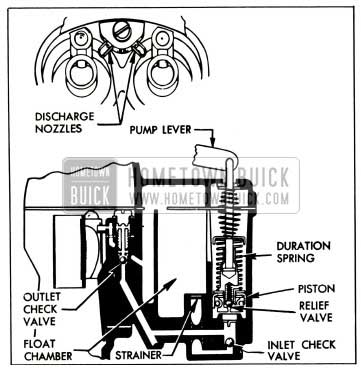
1953 Buick Accelerating System-Stromberg AAVB Carburetor
When the throttle is closed, the pump piston moves up and draws a supply of fuel from the float chamber through the inlet check valve into the pump cylinder. When the throttle valve is opened, the piston on its downward stroke exerts pressure on the fuel which closes the inlet check valve, opens the outlet check valve, and discharges a metered quantity of fuel through the pump discharge nozzles in each, barrel of carburetor. This occurs only momentarily during the accelerating period. The pump duration spring provides a follow-up action so that the fuel discharge carries out over a brief period of time. The relief valve in the pump piston prevents excessive build-up of pressure in the accelerating systems when the throttle is suddenly snapped open.
When the desired speed is reached and the throttle is held in fixed position, the pressure on the fuel in the pump cylinder decreases sufficiently so that the outlet check valve closes and fuel ceases to discharge from the pump nozzles. With the throttle held in a fixed position the fuel flows only through the idle or main metering systems as previously described.
3-25 DESCRIPTION AND OPERATION OF STROMBERG AUTOMATIC CHOKE
General Description
The 1953 Buick Stromberg automatic choke consists of a choke valve mounted on a stem or shaft in the 1953 Buick Stromberg 2-barrel carburetor air horn, .a bi-metal thermostat and cover, a vacuum actuated piston located in a choke housing attached to the air horn, a fast idle rod connecting the choke valve to a fast idle cam mounted on carburetor throttle body. An upper heat pipe connects the choke housing to a lower heat pipe in the exhaust manifold.
The choke valve is mounted off-center in the choke stem so that the force of air stream passing through the air horn tends to move valve to the open position. A short lever mounted on the choke stem in choke housing is engaged by the free outer end of the thermostat which, when cold, tends to close the choke valve. The piston, which is actuated by intake manifold vacuum, is connected by a link to the short lever on choke stem and tends to open the choke valve when the engine fires.
The lower heat pipe in the exhaust manifold heats the air which is drawn through it and the upper heat pipe into the choke housing. A small hole in choke housing permits manifold vacuum to draw the air into the choke housing to heat the thermostat.
The fast idle cam is connected by the fast idle rod to a lever on the outer end of the choke stem so that it is rotated as the choke valve moves. In closed throttle position, the throttle stop screw bears against one edge of the fast idle cam which has a number of steps of different heights to give different amounts of throttle opening, depending on positions of the cam and choke valve.
Choke Operation-Cold Engine
When the engine becomes cold the choke thermostat also becomes cold and increases its spring tension sufficiently Ito close the choke valve. It is prevented from closing the valve, however, because the throttle stop screw holds the fast idle cam in the slow idle position; consequently, the choke valve is held partially open.
When the accelerator pedal is depressed to start the engine, the throttle stop screw is lifted clear of the fast idle cam and the thermostat then closes choke valve. See figure 3-62 (A).
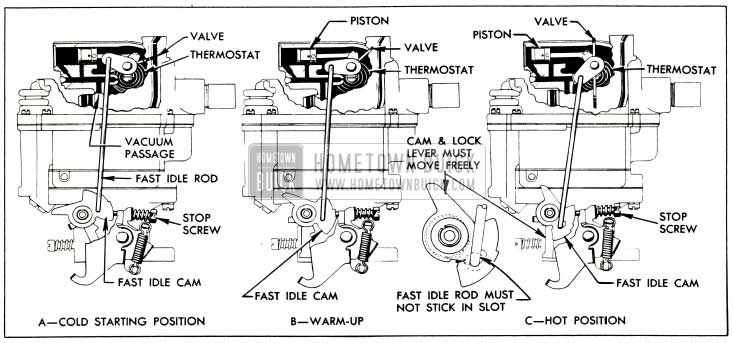
1953 Buick Stromberg Automatic Choke Operation
When the engine starts, intake manifold vacuum causes the piston to partially open the choke valve against the spring tension of thermostat, thereby admitting sufficient air to give a satisfactory running mixture.
When accelerator pedal is released after starting the engine, the throttle stop screw comes to rest against a step of fast idle cam which was rotated to the fast idle position by the closing of choke. This provides proper throttle opening to prevent stalling of the cold engine. See figure 3-62 (A).
If the throttle is partially opened while the running engine is cold, the increased force of air flow against the off-set choke valve will open the valve against the spring tension of the thermostat. These opposing forces balance the choke valve at a position which provides the required choke action without causing loading or an excessively rich mixture. After starting, the vacuum piston does not help to open the choke valve.
Choke Operation-Warm-up Period
As the engine and exhaust manifold warm up, warm air is drawn through the heat pipes into the choke housing by manifold vacuum operating through the small slot in vacuum piston and hole in choke housing. This warms the thermostat, causing it to reduce its spring tension on choke valve in proportion to the increase in temperature.
When the throttle is opened and throttle stop screw is lifted from the fast idle cam, the choke valve then moves to a more open position and the fast idle cam is rotated to bring a lower step into position for the throttle stop screw. The engine will then run at a lower speed at closed throttle. See figure 3-62 (B).
Choke Operation-Hot Engine
When the engine reached normal operating temperature, the choke thermostat is heated to the point where it no longer exerts any spring tension on the choke valve. The choke valve is in the wide open position and the fast idle cam is in the slow idle position so that the throttle stop screw bears against the lowest step of fast idle cam at closed throttle. See figure 3-62 (C).
Choke Unloader Operation
If the engine becomes flooded for any reason, the choke valve can be partially opened by depressing accelerator pedal to the full extent of its travel. This causes a tongue or arm on the throttle lever to contact and rotate the fast idle cam, which forces the choke valve open. See figure 3-63 (C).
3-26 ADJUSTMENT OF FAST IDLE CAM AND CHOKE UNLOADER
If the engine operates on fast idle too long after starting or else moves to slow idle too soon, or the choke unloader does not operate properly, adjust fast idle cam and choke unloader as follows:
- Remove air cleaner and silencer.
- Place a No. 41 drill between wall of air horn and the center of upper edge of choke valve, and hold valve firmly closed against the drill. See figure 3-63 (A).
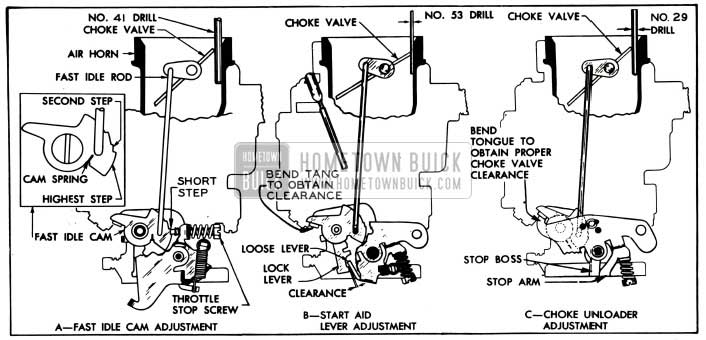
1953 Buick Fast Idle Cam and Choke Unloader Adjustments
3-27 DISASSEMBLY, CLEANING, INSPECTION OF 1953 BUICK STROMBERG 2-BARREL CARBURETOR
Disassembly of 1953 Buick Stromberg 2-barrel Carburetor
- Remove accelerator vacuum switch and gasket.
- Remove cotter pin and disconnect fast idle rod from choke stem lever.
- Disconnect pump rod from pump lever, remove pump lever fulcrum screw (left hand thread), then disconnect pump lever from stem of accelerating pump piston.
- Remove screws and carefully lift air horn straight up from main body to avoid damaging the float, pump piston, and vacuum power piston which are attached to air horn. Remove pump piston. See figure 3-64.
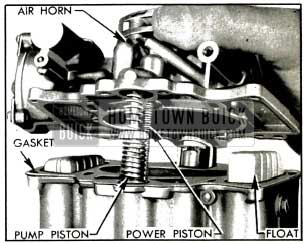
1953 Buick Removing Air Horn and Attached Parts
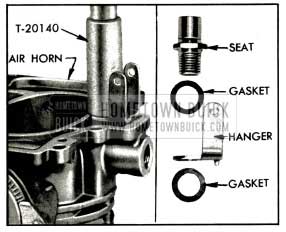
1953 Buick Removing Needle Valve Seat and Float Hanger
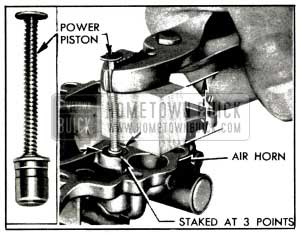
1953 Buick Removing Vacuum Power Piston
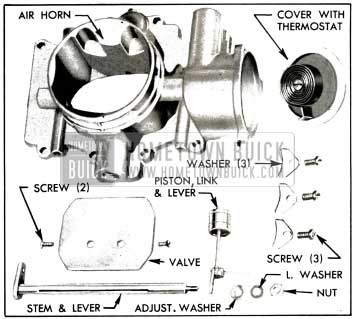
1953 Buick Stromberg Choke Control Parts
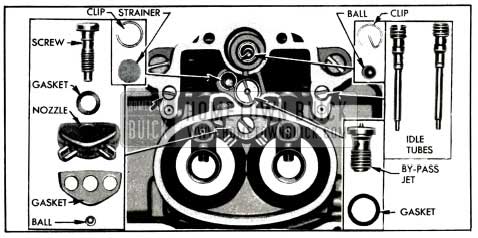
1953 Buick Parts In Main Stromberg Carburetor Body
Handle idle tubes carefully to avoid damaging small end which contains metering orifice.
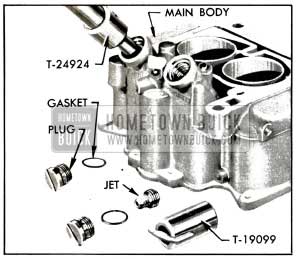
1953 Buick Removing Plug and Main Metering Jet
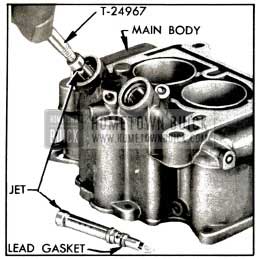
1953 Buick Removing Main Discharge Jet
The threads formed in the main discharge jet by the tool will not affect the metering characteristics of the jet. NOTE: Make sure that main discharge jet lead gaskets are removed from main body.
Cleaning 1953 Buick Stromberg 2-barrel Carburetor Parts
Regardless of the number of new parts that are used in rebuilding a 1953 Buick Stromberg 2-barrel carburetor, the job in the end will not be satisfactory unless all metal parts are thoroughly cleaned. Because of the nature of carburetor parts, with numerous small passages subject to fouling with tenacious carbon and gum deposits, ordinary cleaning processes are entirely inadequate. The correct procedure is to use a cleaning bath in which metal parts can be immersed and “soaked” for sufficient time after disassembly to thoroughly clean all surfaces and channels.
Bendix Metalclene has been developed especially for cleaning carburetors, and is recommended for this purpose. Regardless of the cleaning material used, however, be sure to thoroughly rinse the parts in kerosene, distillate, or white gasoline to remove all gummy deposits that have been softened by the cleaner.
If the passages in main body appear to be heavily fouled with carbon or gum it is advisable to remove the lead ball plugs so that the cleaning solvent can penetrate and wash through the channels. Lead ball plugs may be removed with Plug Remover T-25052, using care not to damage the plug seats in body. See figure 3-71, view A.
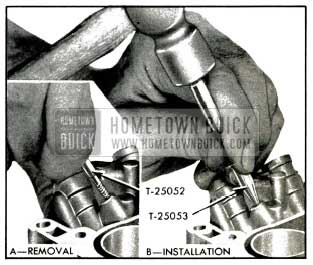
1953 Buick Removal and Installation of Ball Plugs
Install new ball plugs after cleaning is completed, using Plug Set T-25053 to swage plug into its seat. See figure 3-71, view B.
Inspection of 1953 Buick Stromberg 2-barrel Carburetor Parts
After cleaning, all parts should be carefully inspected for wear or damage as follows:
- Air Horn and Choke Parts. It is very necessary for the vacuum piston and the cylinder in air horn to be clean and free of burrs or scores. Do not use any abrasive material for cleaning these parts.
Check clearance of choke stem in bearings of air horn. If stem or bearings are worn so that excessive clearance exists, replace the worn parts. Make sure that bearings are free of gum.
If thermostat is distorted or damaged it must be replaced with a new thermostat cover with thermostat assembly. The thermostat is not furnished separately because the “V” index mark is stamped on cover after installation of thermostat, to insure proper calibration.
Replace inlet strainer if it is damaged or clogged so that it cannot be thoroughly cleaned, using Retainer Clip Replacer T-25360. Use small end of rod of tool to remove retainer clip. To install clip, place it in tapered end of tool sleeve then use rod inside sleeve to push clip into place. See figure 3-72.
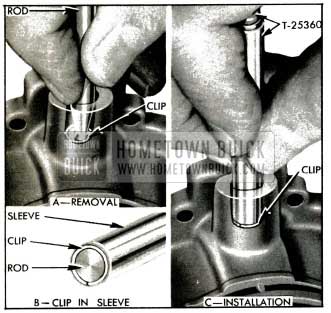
1953 Buick Removing and Installing Retainer Clip
Replace pump strainer if it is damaged or clogged so that it cannot be thoroughly cleaned. Use Retainer Clip Replacer T-25360 as previously explained but use shouldered end of sleeve for installing retainer clip. See figure 3-72.
Replace any parts whose condition appears doubtful.
Test discharge nozzle by sucking or blowing to make sure that all holes are clear. It is advisable to replace pump inlet and discharge channel check valve balls since these parts are small and difficult to inspect.
Inspect check valve ball seats in main body with a good light. If a seat appears rough, place ball in seat and tap lightly to swage a good seat, then discard the ball.
Check the size of the upper idle discharge hole by inserting the shank of the correct size drill. This has the further advantage of removing any foreign matter that may be obstructing the hole. The lower discharge hole for the idle needle valve should be checked in the same manner. For drill sizes see 1953 Buick Stromberg 2-barrel Carburetor Calibrations (par. 3-1).
Make sure that the 1/16″ holes drilled through welsh plugs on rear side of throttle body are clear. These holes permit vapors to escape rather than rising into the air cleaner when engine is stopped.
Inspect seats for idle needle valves for scoring or other damage. If ends of idle needle valves are grooved or bent, replace the valves.
Check wear of throttle stem bearing. There should not be more than about .006″ play, otherwise air leaks will interfere with performance.
Inspect throttle lever and stem assembly for wear on bearing surfaces. Check pump rod holes for wear and also see that lever is not loose on stem. Replace if necessary.
3-28 ASSEMBLY AND ADJUSTMENT OF 1953 BUICK STROMBERG 2-BARREL CARBURETOR
When assembling the 1953 Buick Stromberg 2-barrel carburetor use all new gaskets and any additional new parts found to be necessary during inspection. Calibrated parts must be as specified for carburetor CODE number.
- Attach fast idle rod to fast idle cam with washer and hook the cam spring into groove in rod. Install spacer washer, loose lever lock lever, and fast idle cam on post in throttle body, then install snap ring in groove in post. See figure 3-73.
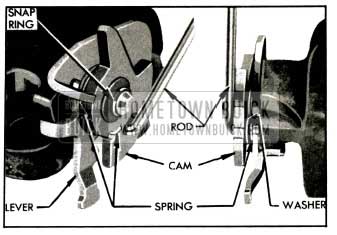
1953 Buick Lock Lever, Fast Idle Cam and Rod
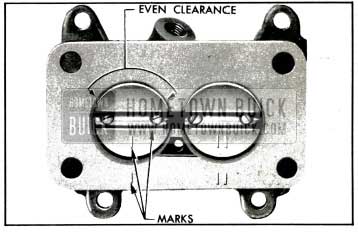
1953 Buick Correct Position of Throttle Valves
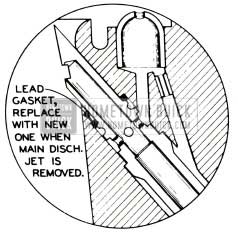
1953 Buick Position of Main Discharge Jet and Gasket
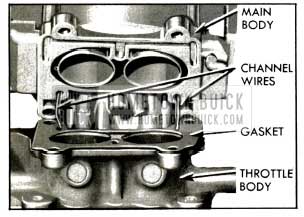
1953 Buick Location of Idle Channel Wires
Install long main body attaching screws on same side as idle needle valves and short screws on opposite side, using lockwashers on all screws.
- Install Gauge T-25046 so that the small hole fits over the pin on choke lever and outer flange of gauge pilots in choke housing. Turn gauge until the two indicator lines on face of gauge are centered on the end of indicator boss on choke housing. See figure 3-77.
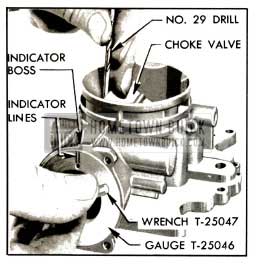
1953 Buick Setting Choke Valve and Vacuum Piston
NOTE: The correct thermostat and cover assembly has the figure “23” stamped on cover adjacent to “V” mark. Do not use a part with any other number. See figure 3-8.
- Install vacuum power piston in air horn and carefully stake in place at three points. Piston must operate freely in cylinder but do not apply lubricant of any kind.
- Install float hanger with a new gasket on each side and install float needle valve seat, using Wrench T-20140. See figure 3-65.
- Place new gasket on air horn. Attach float needle valve to clip on float lever and attach float assembly to float hanger with fulcrum pin, which should be tapped lightly so that serrated end “bites” into hanger leg. Make certain float lever does not bind in float hanger due to distortion of the legs.
- Adjust float for specified height of fuel in float bowl as follows:
- With air horn inverted, place Float Gauge T-24971 on top of gasket so that the locating buttons on gauge fit in holes in air horn. Gauge must rest flat and solid on the gasket. See figure 3-78.
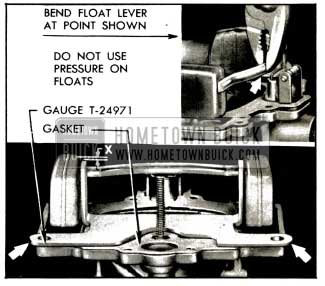
1953 Buick Checking and Adjusting Float Height
Attach pump lever spring with screw adjacent to pump piston stem. Tighten all cover screws evenly.
- Attach pump lever to pump piston stem and install brass washer and cotter pin. Attach pump lever to air horn with fulcrum screw (left hand thread), placing the spring washer between screw head and lever; hooked end of lever spring must engage lower edge of lever.
- Make sure that pump rod is connected to the middle hole in throttle lever, then connect pump rod to pump lever and install brass washer and cotter pin.
- Attach fast idle rod to choke stem lever and install cotter pin. Check adjustment of fast idle cam and choke unloader (par. 3-26).
- Attach accelerator vacuum switch to throttle body with two screws, using a new gasket between switch and body. Check switch timing as described in paragraph 10-30.

Leave A Comment
You must be logged in to post a comment.